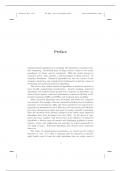Exam (elaborations)
Preface
- Module
- Institution
October 29, 2014 11:19 BC: 9404 Intro to Comp Maths 2nd Ed. Yang-Comp-Maths2014 page v Preface Computational mathematics is essentially the foundation of modern scien ti c computing. Traditional ways of doing sciences consist of two major paradigms: by theory and by experiment. With the ...
[Show more]



